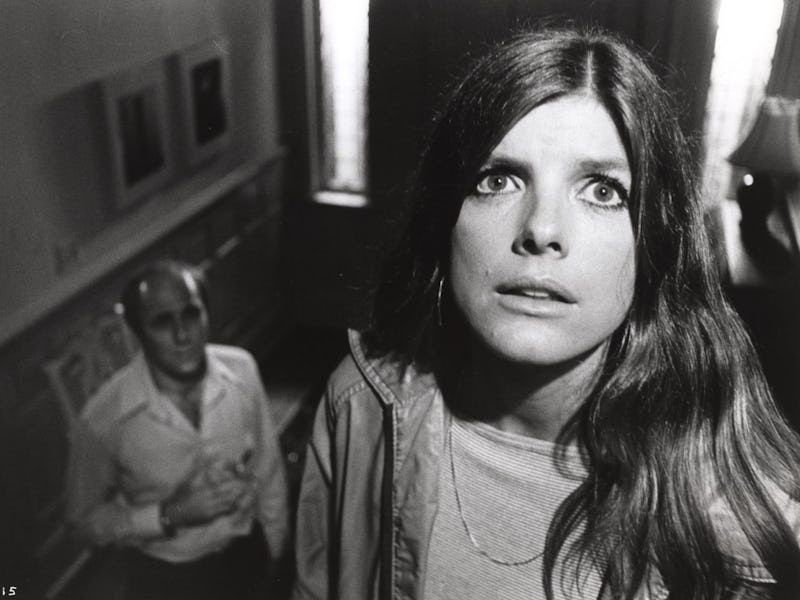The Most Shocking Sci-Fi Film Of The ‘70s Quietly Changed Two Genres At Once
Underrated or misunderstood, The Stepford Wives changed everything.

When somebody wants to insult a certain type of complicit passiveness, they can casually call the person in question a “Stepford Wife.” And anyone who makes this assertion about a person who seems like a social zombie can do so without any fear of being misunderstood. For the past 50 years, a “Stepford Wife” came to mean a brainwashed, vacant person, who is being controlled by someone else, usually a man.
But the funny thing is, this phrase has had an impact on the lexicon, and on culture at large even if people wielding the phrase have never seen the movie from which it came. Just like “jumping the shark” derives from an episode of Happy Days that most people probably have never even glimpsed, the social crime of being a Stepford Wife comes from the 1975 film The Stepford Wives, a somewhat underrated movie that managed to change both the horror and science fiction genres simultaneously. Fifty years later, it's still a great, haunting movie, full of deft tricks that genre film and TV have been trying to replicate for years.
While younger cinephiles might be more familiar with the Nicole Kidman-led 2004 remake (which was directed by none other than Frank Oz), the original was directed by Bryan Forbes and released on February 12, 1975. The screenplay was written by the then-world-famous writer, William Goldman, who prior to this had written such classics as Butch Cassidy and the Sundance Kid and All the President’s Men. Originally based on the 1972 novel of the same name by Ira Levin, Goldman’s screenplay is one of the instances where the book is very much worse than the film. Where the novel wants to be coy about the science-fiction machinations at work behind the scenes, the film makes it clear: In the town of Stepford, Connecticut, housewives are being replaced by servile robot duplicates.
Now, hardcore science fiction fans know full well that the idea of a robot duplicate, even in a domestic setting, was hardly invented by Levin or Goldman. While it’s hard to pinpoint the exact origin of this trope, Ray Bradbury’s 1949 short story “Marionettes, Inc.” (which can be found in The Illustrated Man) has nearly the exact same premise. The difference there is that the idea is for a husband to replace himself with a robot duplicate, while the “real” version goes off and does whatever he wants. Bradbury, ever the moralist, punishes the sexist male characters in “Marionettes, Inc.” with all sorts of body-switching antics. In this sense, Bradbury’s 1949 story is a more optimistic cautionary tale, because it suggests that men and women would have equal opportunity to exploit immoral robot-duplicate technology, while The Stepford Wives suggests that this tech will be controlled by men exclusively.
Like many what’s-wrong-with-this-small-town movies, The Stepford Wives focuses on a newly arrived big-city couple, Joanna (Katharine Ross) and Walter (Peter Masterson). Soon, Joanna becomes aware of a strange quality that many women in the town have. Soon her suspicions led her to form a women’s liberation movement within the town of Stepford, only to be thwarted by the horrible powers that be. In the end, like the ending of the 1978 version of Invasion of the Body Snatchers, Joanna is eventually replaced, and we’re meant to think that the cycle of evil will go on.
Spot the robot.
If this feels a bit on the nose, or obvious in its allegories, that’s sort of the point. But despite what anyone has said about the obvious commentary on the patriarchy and feminism that the film contains, the brilliance of The Stepford Wives is not actually in its hyperbole, but instead, its style.
Unlike the vagaries of the novel, the film makes it clear that these are robots replacing the wives. Crucially, this classifies the film as a science fiction movie. And yet, it doesn’t feel like a sci-fi movie, not a 1970s one, or a modern one. It also doesn’t really feel like a horror movie, even though it’s basically very similar to a variety of Stephen King small-town set-ups. The movie, through wonderfully understated aesthetics, simply feels like a movie. Almost genreless, it actually presents both its horror tropes and sci-fi tropes casually, as though these aren’t just fantastical allegories about sexism, but merely facts about how parts of the world might work.
Today, 50 years later, with the rise of AI companions, The Stepford Wives feels even more like science fiction, but only because of how old-fashioned the analog, physical robot is, relative to the AI lovers that live in people’s computers today. In a twisted way, The Stepford Wives suggested that even in a worst-case scenario, horrible men would still want a physical presence. What the AI revolution of today has indicated is that perhaps the concept of The Stepford Wives didn’t go far enough.